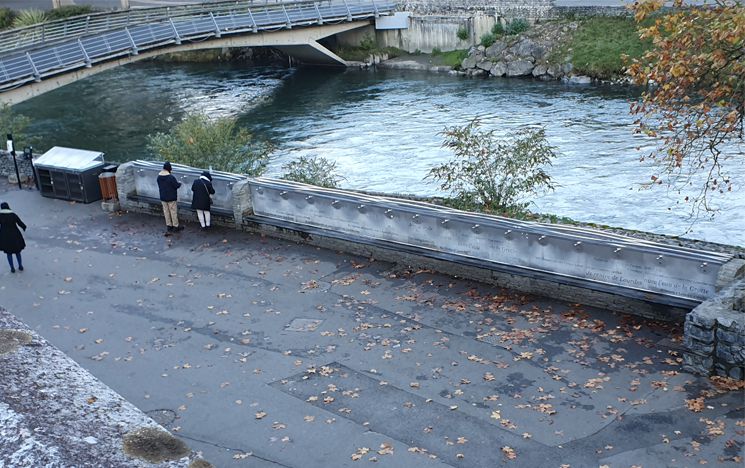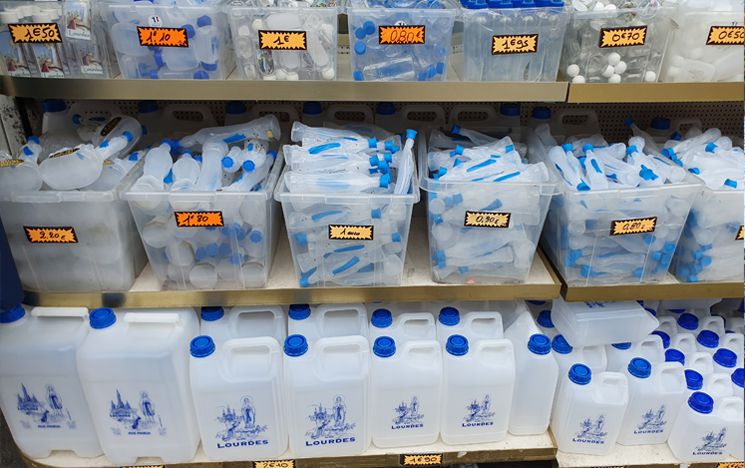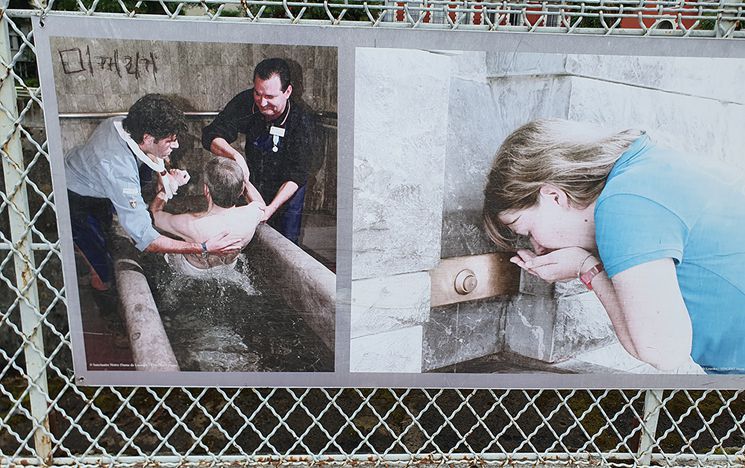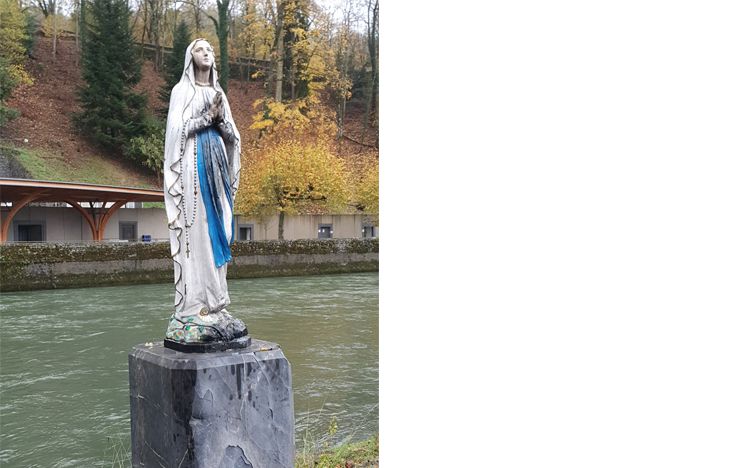The Water of Lourdes
Jon Mitchell
During the ninth of St Bernadette’s eighteen visions at Lourdes, she was told by Our Lady to wash in, and drink water from a freshwater spring revealed to her in the grotto. This was in 1858, but the same spring – and the same spring water – is still to this day a central focus for pilgrims to Lourdes. The spring is visible behind a glass screen in the grotto, and supplies water to baths and taps in which pilgrims wash and drink. Of course, it is not exactly the same spring water. The spring clears 122,000 litres/27,000 gallons per day, so is never actually the same water. Yet the enduring flow from the same ground source gives significance to the mimetic act of washing and drinking in the same water as Bernadette.
According to the Romanian religious scholar, Mircea Eliade, water is a perfect metaphor for life, and is consequently a key element of religious symbolism across diverse traditions. Water is seen as the source of all things and all existence. Contact with water, therefore, symbolises a return to this original essence; a cleansing and absolution; a healing and curing; a rebirth. In the Christian traditions, water is used for baptism, and in Catholicism for blessing of persons, objects, and places.
Yet the significance of water is more than merely symbolic. At Lourdes it is also experiential; it is physically and bodily engaged with, as pilgrims wash in it and drink it. This is not merely bodily engagement with a holy object, however, but a substantive incorporation of the very object itself. It is sometimes done contemplatively, in remembrance and imitation of Bernadette’s initial instruction from Our Lady, but just as often more casually – indeed perhaps even more so – to keep hydrated. For many pilgrims the only water they drink during their pilgrimage to Lourdes is from the spring-water taps, collected regularly in their own re-fillable water bottles, or those purchased from the many Lourdes souvenir shops.

Figure 1: Spring water taps opposite the grotto

Figure 2: Bottles for sale in a Lourdes souvenir shop
For the anthropologist, Veronica Strang, the ingestion of water establishes a continuity between body and environment that confirms the permeability or porousness of the self:
‘In the process of being ingested, water is incorporated, becomes (at 67 per cent) a major part of the body and thus demonstrating both the contingent stability of the body and the permeability of the person as an ‘assemblage’ of both internal and external matter’ (Strang 2014: 135).
Water, then, immerses the pilgrim in the physical, emotional, and spiritual environment of the shrine. It is also a material reminder of the permanence and ephemerality of life.
Although they emulate the actions of St Bernadette, contemporary pilgrims’ engagement with the waters is mediated by a substantial infrastructure. Within two years of Bernadette’s visions, local masons had constructed two baths in which visiting pilgrims, and particularly the sick, could bathe. The Mayor of Lourdes hoped to turn the town into a wealthy spa, like the neighbouring Bagneres-de-Bigorre and Cauterets, but when it was discovered that the waters had no special mineral characteristics, this was abandoned. Rather, the waters were taken up and taken over by the faithful, who picked up on the trend for curative immersion to develop the shrine as a kind of spiritual spa, where healing came from faith.
As the shrine expanded so did the baths. In 1880, a wooden structure was built to house fourteen pools, which were upgraded in 1891, with the Virgin’s blue tiling and individual compartments for changing and bathing. These were replaced and updated in 1955, 1972 and 1980. The current baths are housed in a low building close to the grotto and are open for two sessions daily – morning and afternoon. Pilgrims queue below a wide veranda, ushered by hospitality volunteers before entering the baths.
With the baths came accounts of miraculous cures. In 1862, seven cures were authenticated as miracles by the Church authorities, and claims to miracles were a daily occurrence. In 1883 a Medical Bureau was established to test the authenticity of miracle claims. As of 2023, it had verified seventy miraculous cures, whilst it estimates that more than 7,000 claims have been made (The miracles of Lourdes).

Figure 3: Street poster depicting immersive bathing and drinking the waters
In the archives of the Archdiocese of Birmingham, there is an account of a car journey to Lourdes by Reverend Thomas Williams, in 1913. He stayed several days and was particularly impressed by the efforts made by diverse people, to transport sick pilgrims to the baths:
‘Army officers, priests, University Professors, all classes are busy all morning carrying the sick to the baths, and afternoon to and from processions…women too of the highest mark of society help to look after the sick.’
He was particularly impressed by the daily procession of the Blessed Sacrament, which since 1888 had also included a blessing of the sick. It was at this procession that he observed numerous miraculous cures: ‘When a miracle happens people begin to clap and cry out, and the priests start saying Pace Domine…First day one cured; second day 4 cured, really far more, third day 5 or 6.’
Many of those cured were disabled by rickets or polio, so would stand and cast aside their crutches or leg-irons, which were collected and displayed next to the Lourdes grotto. Such spontaneous claims of instant cure are less common in the twenty-first century, and the collection of abandoned crutches and leg-irons no longer adorns the grotto.
Modern pilgrims don’t necessarily approach the baths with the expectation of miraculous cure, particularly since the advent of the ‘water gesture,’ which has replaced immersive bathing since the COVID-19 pandemic. The gesture involves washing the hands and face with water poured by one of the shrine volunteers, and is understood by pilgrims as being more symbolic than substantive. For some, this is a welcome return to Bernadette’s original actions - after all, she didn’t bathe in the waters - and a reminder that miracles come from faith. Also, that miracles may not necessarily involve spectacular cure. Many pilgrims refer to the miraculous capacity of engaging with the waters to bring peace and resolution - to help them come to terms with illness or misfortune.
For others, the abandonment of immersive bathing reduces the potential for minor - or indeed major - miracles. One woman who had frequently volunteered in the baths described to me a paraplegic pilgrim, who was assisted into the baths, and as soon as she entered this quiet and contemplative space began loudly moaning and shouting – ‘like she enjoyed the sound of her own voice’ – but when she was immersed the shouting stopped, and she relaxed. The water is cold, at 12 degrees Celsius, and bathers refer to the shock of the experience. A South Asian man described how when he was immersed, the cold was immediately replaced by an intense heat that radiated inwards: ‘I felt like I was in a hot bath; I could have stayed there all day.’ Like others, he described how the water seemed not to cling to his skin after he got out of the bath: ‘It seemed to evaporate, or soak in,’ he speculated.
Thus, although it is acknowledged that there is nothing scientifically significant about the water, it is seen to have special material properties – that are felt experientially, through the body. Sensing the water confirms this, but also confirms the possibility of the miraculous. Before his Lourdes visit, the South Asian man said that he had been having problems with a work colleague. He was stressed. But the act of bathing relaxed him, and what was more, when he returned home the troublesome colleague had resigned. This had to be a sign of the power of the water; and of Our Lady’s intercession.
As well as filling the baths, the Lourdes spring water also feeds numerous rows of taps that surround the grotto. On summer days, particularly at weekends and on feast days, there are long queues as pilgrims wait to accomplish their own ‘water gesture’ – taking water from the tap into their two hands, drinking a little then using the rest to wash their face and hands – or fill containers with the water, either to drink during the day or to take back home for themselves, or to distribute among family and friends. The shrine itself sells small glass bottles – small enough to be carried in aircraft hand luggage – but the surrounding souvenir shops have plastic bottles of all sizes, all printed with images of Our Lady. It is not uncommon to see people filling several five litre containers to take home in their cars. Through the water, the presence of Lourdes is transported and rationed until the next visit – or the next time a family-member brings back water from their visit.
Many pilgrims are frequent visitors to Lourdes – those from the UK often coming regularly with organised Diocesan or parish pilgrimages. One woman from Birmingham who had been coming annually for more than fifteen years explained that she always took home enough water to last the year, until the next pilgrimage. She keeps the water near her front door and will dab a couple of drops on her temples as she leaves the house: ‘It’s reassuring on days when my social anxiety is bad.’ For another, the water that she takes home from Lourdes keeps her anchored in her faith: ‘I’m not a good Catholic. I don’t go to church very often and don’t pray very much. I can’t remember the last time I went to confession. But the water keeps me attached. It makes me feel part of something.’ Lourdes water is considered particularly effective for blessing. As one priest revealed: ‘Without a doubt, Lourdes water is considered more powerful. Whenever I am asked to do a blessing and they have Lourdes water, they will always want me to use that. It’s much better than my own Holy water.’
When taken home, the water of Lourdes is mainly used externally to the body, rather than for drinking. But as a man emphasised: ‘So long as you don’t open the bottle you can keep the water for years and it will still be good for drinking.’ Most water-drinking is done during pilgrimage itself, though, and a number of regular pilgrims referenced a need to ‘top up’ their Lourdes water levels during pilgrimage, as they simultaneously ‘top up’ their faith:
‘The annual pilgrimage sort of tops up my religious feeling. By the end of the year I can feel it dwindling and...[she gestures with her hands]...it’s time to top it up again. A bit like the water, really. That gets topped up and I get topped up.’
Water flows through the landscape of Lourdes, as it flows upon and through the bodies of the pilgrims who visit. The water is a vehicle for faith, but also for grace, intercession and the possibility of the miraculous. Pilgrims often refer to Lourdes as a ‘thin place.’ where the boundary between heaven and earth is particularly permeable. This permeability is enacted through the very bodies of the pilgrims themselves, through and with the water of Lourdes.

Figure 4: Statue of Our Lady next to the Gave river, with the baths in the background